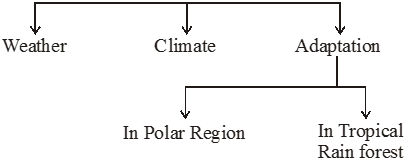Weather
- Books Name
- CBSE Class 7 Science Book
- Publication
- Param Publication
- Course
- CBSE Class 7
- Subject
- Science
Weather
• Weather plays an important role in our lives. In cold weather we protect ourselves by wearing woolen clothes while in hot weather we use certain cooling devices like fan, cooler or air conditioner to keep ourselves cool.
• We wear raincoats or use umbrellas to escape from the rain. We plan many of our day-to-day activities on the basis of prevailing weather conditions. We plan a picnic on a cool, pleasent and cheerful day and not on a hot and sultry day. We even plan a trip to a hill station or any other place after taking into account the weather conditions of that place.
• Weather is defined as the state or condition of the atmosphere of a particular place, at a particular time in term of humidity, cloudiness, temperature, windspeed, etc.
• People who study and record weather are called meteorologists.
• The study of weather is called meteorology.
• Rainfall is measured by an instrument called the rain gauge. It is basically a measuring cylinder with a funnel on top to collect rain water.
• The hygrometer is used for humidity measurement. The amount of water vapour present in the air is called humidity.
• The maximum and minimum temperature are recorded every day by special thermometers called maximum and minimum thermometers.
• The maximum temperature of the day occurs generally in the afternoon while the minimum temperature occurs generally in the early morning.
• All kind of changes in the weather are caused by the sun. There are variation in time of sunrise and sunset. Due to which days are longer in summer than winters. Sun is a huge sphere of hot gases having high temperature although distance of sun from earth is very large but energy sent by sun is the main source of all heat and light on the earth. Thus sun is the primary source of energy that causes changes in the weather. Earth surface, oceans & atmosphere absorbs and reflects the solar energy, which play important roles in determining the weather at any place. Due to this property changes in weather occurs near oceans, mountains and in desert etc.
Weather Forecasting
Weatherman to a certain extent can predict or estimate what the weather will be like in the near future. This is called weather forecasting. It gives the following information :
(i) Maximum and minimum temperature of the past 24 hours
(ii) Humidity / relative humidity
(iii) Rainfall
(iv) Time of sunrise and sunset
(v) Time of moonrise and moonset
(vi) Prediction of weather for the present day
Climate
- Books Name
- CBSE Class 7 Science Book
- Publication
- Param Publication
- Course
- CBSE Class 7
- Subject
- Science
Climate
• The average weather pattern taken over a long time say 25 years is called as the climate of the place.
• It is the average weather conditions of a particular region of earth or area with regard to temperature, rain fall, air pressure, seasonal variations etc.
• Temperature, rainfall, solar radiations and air pressure determine the climate of an area. The variations in climates develop due to different duration, angle and intensity of solar radiations in different areas of the world, resulting in movement of winds and ocean currents.
• Climate determines the flora and fauna of a place. Local variations of a climate that occurs in an area of limited size is called micro-climate.
• If the temperature and rainfall at a place is high most of the time then the climate of that place is hot and wet.
• By taking information about climate of two places in India, we can compare climate of these regions. For eg. Jammu & Kashmir and Kerala. We find that Kerala is very hot & wet in comparison to Jammu and Kashmir.
• Similarly data of western region of India i.e. Rajasthan, shows that the temperature is very high during most of the year. Winter lasts for a few months and temperature is quite low. This region receives very little rainfall, thus this is a typical desert climate and it is hot and dry.
• The north-eastern part of India receives rain in most of the year. Thus, the climate is wet.
Difference between weather and climate

Climate and Adaptation.
- Books Name
- CBSE Class 7 Science Book
- Publication
- Param Publication
- Course
- CBSE Class 7
- Subject
- Science
Adaptation
Adaptation are special characteristics developed by organisms to live comfortably and successfully under a prevailing set of environmental conditions. Adaptations may be morphological, physiological or behavioural or a combination of them. Adaptation develop through the process of natural selection. The ultimate aim of all adaptations is to make the individual fit to obtain food & space for its survival, opportunities for its reproduction & rearing of young ones.

Adaptation of animals to climate
Climate of an area greatly affect the flora, fauna and soil of the region. Animals are well adapted to their surrounding conditions, so that they can easily survive. Animals special features and habits helps them to adapt themselves to surroundings that result in evolution.

 Grow Career Publication
Grow Career Publication
 Param Publication
Param Publication
